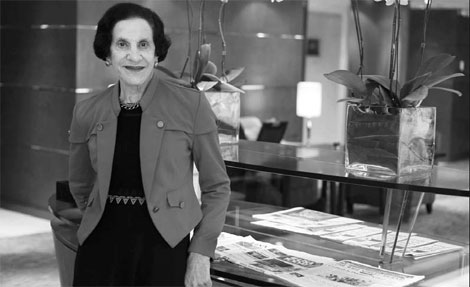Sensing the beauty of China
 |
|
Marie Bashir says she has a connection with China spanning nearly four decades. Wang Jing / China Daily |
Chancellor of the University of Sydney and governor of New South Wales Marie Bashir has had an enduring fascination with the country since she was a child. Zhang Yue and Guo Shuhan report.
A group of 200 Chinese students in graduation gowns took turns stepping onto the stage to accept their degrees from Marie Bashir, chancellor of the University of Sydney and governor of New South Wales, at a recent graduation ceremony exclusively for Chinese graduates and their families.
"When Ms Marie Bashir held my hand firmly, looked into my eyes and said my name I suddenly felt that the moment didn't end my student life in Sydney but instead maintained my connection with the country," says Liu Biwei, a 25-year-old Sydney University graduate who earned her master's degree in commerce
The annual event has become one of Bashir's most cherished activities since 2007, when she assumed her post as chancellor.
She says it provides her with the opportunity to keep in touch with youngsters in China, a country she was curious about in her childhood and connected to 37 years ago.
Bashir's knowledge about China began with her parents.
"Although my parents had never been to China, they were interested in Chinese arts. My family has had a bunch of traditional Chinese handicrafts and embroideries since my childhood, like bed sheets, tablecloths and pillows," she says.
"From them, I could sense the beauty of China."
Bashir has spent most of her life in medicine, which is a family tradition. After graduating from Sydney University, she operated the Rivendell Unit in Sydney for children with emotional and psychiatric problems in the 1970s.
As her medical career progressed, her knowledge about China also grew from Chinese magazines. One of the terms she learned from these was the "barefoot doctors", a term that came from southern China. It refers to farmers who received basic medical training and brought healthcare to rural villages where most urban doctors would not consider settling. This impressed her.
"That was something hard for me to imagine as a medical student. I wanted to see how they took immunization and public health to the furthest areas of the provinces. So I decided to go and see for myself," she says.
Her wish to visit China came true in 1974, when she and her aunt took a flight to Hong Kong and then spent three weeks in Guangzhou, Shanghai and Beijing.
As one of the first batch of Australian visitors to China, she says the trip struck her greatly.
"I got a chance to see how the barefoot doctors were taking immunization and public health to rural villages," she says. Once there, she was not able to sleep and found herself walking through the streets at night.
"I was drawn to people's faces, mothers with babies on their backs, those wonderful faces," she recalls. "So much hardship and poverty but so much love for their children. Though the kids were comparatively thin and short due to the lack of food at that time, there was joy and hope on their faces that you could sense."
It was also during that visit that she was amazed by traditional Chinese medical treatments in rural areas, where brain tumors were removed with the assistance of acupuncture, which was used to sedate people who did not have anesthetics.
In 1984, she and her family were invited to attend the 35th anniversary of the founding of the People's Republic of China, held in Beijing.
"We were given a place to stand on Tian'anmen Square with other Australians and saw an incredible procession and festivities," she says. "People looked healthier, and there was great joy and passion on their faces. The progress is incredible."
Since then, Bashir has taken her family to China many times. Her visits to China during the 1980s renewed her impression of progress, especially when she and her aunt took a ride along the Yangtze River, visiting Hubei's provincial capital Wuhan, one of her favorite cities.
Her return to China several years later led to her acquaintance with some famous individuals.
Bashir was introduced to George Hatem (1910-1988), an American doctor who had worked in China since the 1930s. Hatem also introduced Bashir to one of the most famous figures of 20th century China, Madame Sun Yat-sen, one of the three famous Soong sisters.
"She was warm and lovely and expansive, and I was rather in awe of her," Bashir admits.
In September, Bashir attended the celebration for the 100th anniversary of the 1911 Revolution - the civil war led by Sun Yat-sen, which overthrew the Qing Dynasty (1644-1911) - held by Chinese associations in Sydney.
"I admire the Chinese people's love of learning, their diligence. So much of what they do and have created has come about because of meticulous attention to detail: their calligraphy, pen etchings, porcelain. And their respect for teachers and education - I applaud all of that."
















